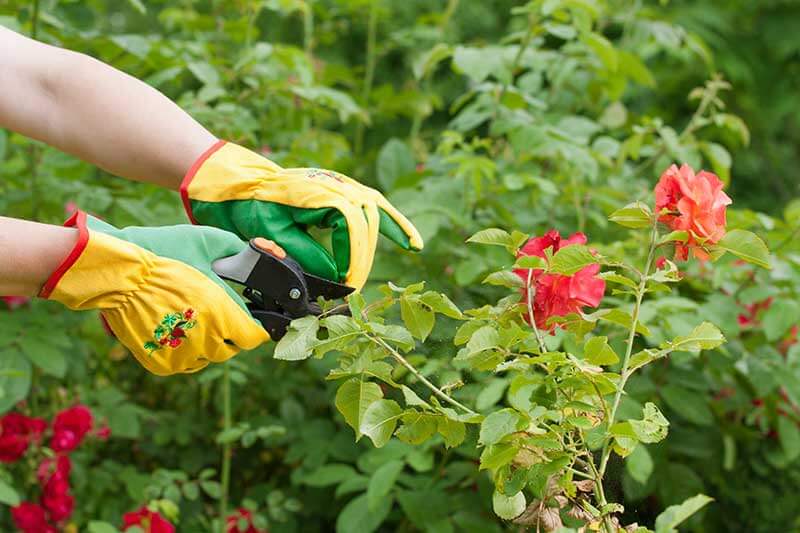How to Control and Prevent Black Spot Damage on Roses
Identifying and Understanding Black Spot
Considered the most significant rose disease nationwide, black spot reveals itself as dark, rounded leaf spots with feathery, irregular borders. Unlike some common fungal diseases, black spot only appears on the topsides of leaves and stems, never on the undersides of leaves. As the disease progresses, leaf areas surrounding dark spots become yellow. The yellow areas then expand to cover entire leaves. Infected leaves eventually drop off plants completely, leaving your roses weakened, stressed and vulnerable.1,2 Some fungal diseases spread on wind, but the spores behind black spot move with the help of water. Cool, wet spring days and moist nights are prime conditions for black spot to take hold on roses and spread. Once black spot becomes active, the disease cannot be stopped without effective fungal controls. Embattled roses have fewer flowers, and those produced are inferior to what could have been. With black spot present everywhere roses are grown, prevention and prompt intervention are essential to keep roses healthy, productive and beautiful.1,2

Counteracting Black Spot on Your Roses
Fighting black spot effectively in roses involves a three-prong treatment approach. The American Rose Society and the University of California Integrated Pest Management Program note that pesticides containing the active ingredient chlorothalonil are effective components of programs to counteract rose black spot in various stages.3,2 Chlorothalonil-based GardenTech® Daconil® Fungicides fight black spot in roses in three important ways:1. Prevention
Protecting your roses before they become infected with black spot is the most important step against this disease. This is especially important when you've had black spot before or when moist conditions encourage its spread. Start preventive treatments with Daconil® fungicide at what's known as “bud break," in early spring. That's the point when the small buds along rose canes begin to swell and come out of dormancy. By treating every seven to 14 days, or until conditions no longer favor the disease, unfurling new leaves are protected right from the start.
2. Suppression
If black spot is already active on your roses, move quickly to control and stop its advance. Unless you treat with a highly effective product such as Daconil® fungicide, black spot can move through your garden — and it won't stop at roses. Begin active treatments with Daconil® fungicide at the very first sign of disease to stop black spot and limit its damage. Treat every seven to 14 days or as long as weather conditions warrant, and mark your garden journal to remember to start preventative treatments early next year.
3. Protection
Another important aspect to treating infected roses is protecting healthy tissue from new infection. Even when black spot is active on a rose, there's hope. Your regular treatments with Daconil® fungicide protect the healthy parts of roses from succumbing to the disease, as it stops and controls disease in infected parts.

Helping Roses Stay Healthy and Disease-Free
While Daconil® fungicide works to prevent, control and protect your roses, you can do your part, too. Simple changes in the way you maintain your garden can help prevent black spot and other the fungal diseases from becoming active and spreading. Follow these tips to help roses and other garden plants stay their healthy best:- Provide good air circulation. Disease-encouraging water and humidity disperse and dry more quickly when plants aren't overcrowded.
- Water early in the day. Morning sun helps leaves dry quickly. When you water at night, leaves stay wet — and vulnerable to disease — all night long.
- Avoid overhead watering. Use drip irrigation or water by hand at ground level to keep leaves dry and free from water that black spot and other diseases use to spread.
- Practice good sanitation. Prune out infected stems, and clean up fallen leaves. Dispose of them; don't compost them. Disease can overwinter on infected debris.
- Sterilize pruners regularly. Use a full-strength household cleaner to wipe pruner blades before and after every cut when black spot is present. Dirty pruners can spread disease.
- If insect pests invade your roses, turn to Sevin brand insecticides for protection you can trust.
With these tips and Daconil® fungicide at work in your garden, you can prevent, control and stop black spot and many other common garden fungal diseases. GardenTech® brands and the GardenTech blog are here to help you grow beautiful, healthy roses, and enjoy all the rewards gardening has to offer.

Always read product label thoroughly and follow instructions carefully. Daconil is a registered trademark of GB Biosciences Corp. GardenTech is a registered trademark of Gulfstream Home and Garden, Inc.
Sources:
1. Missouri Botanical Garden, “Rose Problems," June 2014.
2. J.F. Karlik and D.A. Golino, “Roses: Diseases and Abiotic Disorders," University of California Statewide Integrated Pest Management Program, May 2009.
3. Danny Craft, “What Is Blackspot?," American Rose Society.
Get Monthly Gardening Advice!





